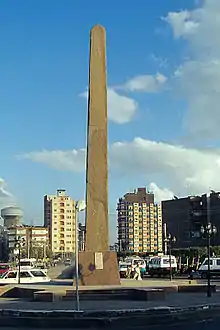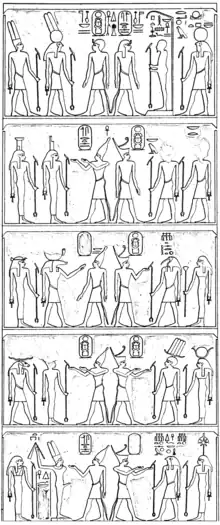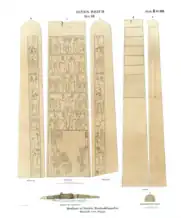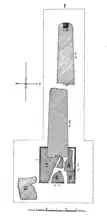
The Abgig obelisk (also known as the Begig obelisk and the Faiyum obelisk) is an ancient stone monument erected by the Egyptian pharaoh Senusret I in the 20th century BC near what is now Faiyum. Made of red granite, it is likely that the obelisk once stood 12.9 metres (42.3 ft) high with a base of four limestone slabs. While the structure was still upright in the 17th century, by the early 19th, it had been toppled and split in two.
The obverse side of the obelisk features five detailed registers, each of which depicts two instances of Senusret I facing various Egyptian gods; the obverse side once also featured a now-lost hieroglyphic inscription. While the Egyptian government restored the obelisk in 1972 and placed it near the entrance of modern-day Faiyum, centuries of neglect and exposure have badly eroded the monument.
History
The Abgig obelisk was erected in the 20th century BC by pharaoh Senusret I (second pharaoh of the Twelfth Dynasty of ancient Egypt), roughly 3 kilometres (1.9 mi) southwest of present-day Faiyum.[1][2] Archaeological reports from the early 20th century confirm that the toppled remnants of the monument were not located near any other major structures,[3] and both Marco Zecchi and Roland Enmarch note that there is little if any evidence that the obelisk was originally erected elsewhere before being relocated to Faiyum. To account for its otherwise isolated location, scholars such as Enmarch, Sydney Hervé Aufrère, and Jean-Claude Golvin have suggested that the monument was likely once part of a larger religious complex that was lost at some point in antiquity.[1][4]
The earliest post-antiquity mentions of the obelisk were made in 1672 by Johann Michael Vansleb,[2] and by Richard Pococke in the mid-18th century; the latter, in his work Description of the East, described the structure as "a very particular obelisk of a red granite" that was "much decay'd all round for ten feet high, but mostly on the south side; the west side is almost entirely defaced, and at the south west and south east corners, it is much broken for about twenty feet high".[5] Pococke's description suggests that the obelisk was still standing in the 17th century, but by the time the French engineer Philippe Joseph Marie Caristie visited the monument near the turn of the 19th century, it been "knocked down on the ground [and] broke[n] into two pieces".[6]
In the following years, the obelisk was visited and described by Edward William Lane (1827),[7][8] and John Gardner Wilkinson (1827),[8][9] and Karl Richard Lepsius (c. 1842–1945).[10][11] In 1925, Mohamed E. Chaaban excavated the area around the fallen obelisk and discovered its base.[10][12] Chaaban also unsuccessfully searched for the figure that may have once rested on the top of the monument.[12] In 1972, the obelisk was restored by Egyptian authorities and moved to Medinet el-Fayyum.[10][13] However, due to centuries of neglect and exposure to the elements, hardly anything remains of the monument's inscriptions or its registers.[10][14] For this reason, Lepsius's detailed drawings of the monument are considered "of permanent value for its study".[10]
Description
The obelisk of Abgig is made of red granite[2] and when first erected, it likely stood 12.9 m (42.3 ft) high, with a base (composed of four limestone slabs) that measured 3.6 m (12 ft) by 3.6 metres. The obelisk tapers upwards and has a rounded top. There is a recess in the middle of the obelisk's crest, which may have once housed a sculpted figure. Gaston Maspero and Hourig Sourouzian have both argued that this figure was probably a falcon made of metal,[10] although Marco Zecch argues that this suggestion is speculative at best.[4]
Obverse side
The obverse (north) side of the obelisk features five detailed registers, each of which depicts two instances of the pharaoh Senusret I (identified in several places as "Kheper-ka-ra" [ḫpr-kꜣ-rꜥ], which means the "Manifestation of the Ka of Ra")[15] standing back-to-back; each instance of the pharaoh, in turn, is facing a unique pair of gods. As Lisa Saladino Haney notes, these deities are not identified on the obelisk with "Fayumic epithets", suggesting that the monument's purpose was to establish "dynastic presence in a provincial region" rather than syncretize local religious beliefs.[16] A description of the registers (arranged from top to the bottom) is as follows:

| Reg. | Left-hand side | Right-hand side | Ref. |
|---|---|---|---|
| 1 | Senusret I, wearing a headscarf, faces Amun (left) and Montu (right). | Senusret I, wearing a headscarf, faces Ptah (left) and Ra-Horakhty (right). | [17][18] |
| 2 | The king, wearing the white crown, presents an offering to Nephthys (left) and Isis (right). | The king, wearing the red crown, faces two male deities (possibly Horus and Set) | [19][20] |
| 3 | The king, wearing the white crown, faces Renenutet (left) and Sobek (right). | The king, wearing the red crown, faces Thoth (left) and an unknown goddess (right). | [19][20] |
| 4 | The king, wearing the white crown, presents an offering, likely to Khnum (left) and either Neith or Satet (right). | The king, wearing the red crown, presents an offering to Anhur (left) and Hathor (right). | [19][20] |
| 5 | The king, wearing the white crown, invokes an unknown goddess (left) and Min (right). | The king, wearing the red crown, presents an offering to the falcon-headed god "foremost of Khem" (left) and to Seshat (right). | [20][21] |
Below the fifth register, there once existed fourteen columns of hieroglyphs. By the 19th century, this text had been badly eroded, and Lepsius was able to copy only parts of the inscription. Today, none of this inscription remains.[10][22] Because the text copied by Lepsius is so fragmentary, determining what the inscription once said is likely impossible. That said, Zecch postulates that the columns may have recorded a speech that Senusret I delivered to his court concerning the construction of new monuments. Zecch bases his hypothesis on the fact that similar inscriptions have been identified on a variety of objects that were constructed during Senusret I's reign.[23] Roland Enmarch has likewise suggested that the text is an example of a königsnovelle (i.e., "a specific literary form describing a unique event in the life of the king-a single, simple, great deed").[24][25][26]
Eastern and western sides
On the eastern side of the monument is a hieroglyphic inscription that reads: "Horus Ankh-mesut, Two Ladies Ankh-mesut, king of Upper and Lower Egypt Kheper-ka-ra, beloved of Montu, lord of Thebes [...]". On the western side, there is a similar inscription that reads: "Horus Ankh-mesut, Two Ladies Ankh-mesut, king of Upper Egypt Kheper-ka-ra, beloved of Ptah south of his wall [...]".[27]
Reverse side
Unlike the obverse side, the monument's reverse (south) side has not been as thoroughly documented. This face of the monument features a register in which two depictions of the king are shown standing back-to-back. While the figure on the left has been eroded considerably, the one on the right has largely been preserved. In the preserved portion, the king—explicitly identified as "the good god Senusret" (nṯr-nfr Snwsrt)—is shown wearing the white crown and offering vases to Atum and another unknown god.[27]
See also
References
- 1 2 Enmarch (2013), p. 21.
- 1 2 3 Zecchi (2008), p. 373.
- ↑ Chaaban (1926), pp. 106, 108.
- 1 2 Zecchi (2008), p. 378.
- ↑ Pococke (1743), pp. 59-60
- ↑ Caristie (1818), p. 43.
- ↑ Lane (2000), pp. 230, 237-238.
- 1 2 Zecchi (2008), p. 374.
- ↑ Wilkinson (1843), pp. 342–43.
- 1 2 3 4 5 6 7 Zecchi (2008), p. 375.
- ↑ Lepsius (1849), plate 119.
- 1 2 Chaaban (1926), pp. 105–108.
- ↑ Leclant (1973), p. 405.
- ↑ Zecchi (2005), p. 380.
- ↑ Leprohon (2013), p. 58.
- ↑ Haney (2020), p. 351.
- ↑ Zecchi (2008), pp. 375–376.
- ↑ Hirsch (2004), pp. 54–55.
- 1 2 3 Zecchi (2008), p. 376.
- 1 2 3 4 Hirsch (2004), p. 55.
- ↑ Zecchi (2008), pp. 376–377.
- ↑ Zecchi (2008), pp. 379.
- ↑ Zecchi (2008), pp. 381.
- ↑ Enmarch (2013), pp. 23–24.
- ↑ Spalinger (1983), p. 102.
- ↑ Malleson (2019), p. 50.
- 1 2 Zecchi (2008), p. 377.
Bibliography
- Caristie, Philippe Joseph Marie (1818). "Description de l'obélisque de Begyg, auprès de l'ancienne Crocodilopolis". In Commission des Sciences et des Arts (ed.). Description de l'Égypte (in French). Vol. II: Antiquités, Descriptions. Paris, France: Imprimerie Royale. pp. 43–45. doi:10.11588/diglit.4811#0334.
- Chaaban, Mohamed E. (1926). "Rapport sur une mission à la l'obélisque d'Abguîg (Fayoum)". Annales du service des antiquités de l'Égypte (in French). 26 (2): 105–108. Retrieved March 14, 2023 – via The Internet Archive.
- Enmarch, Roland (2013). "The Traces of the Inscription on the Abgig Monument of Senwosret I". In Frood, E.; McDonald, A. (eds.). Decorum and Experience: Essays in Ancient Culture for John Baines. Oxford, UK: Griffith Institute. pp. 21–25. ISBN 9780900416927.
- Haney, Lisa Saladino (2020). "The Development of Religious Symbolism and Iconography in the Setting of Coregency: a Case Study". Visualizing Coregency. Harvard Egyptological Studies. Leiden, The Netherlands: Brill Publishers. pp. 339–363. doi:10.1163/9789004422155_008. ISBN 9789004422148. S2CID 216174483.
- Hirsch, Eileen (2004). Kultpolitik und tempelbauprogramme der 12. Dynastie. Schriften zur Ägyptologie (in German). Berlin, Germany: Achet-Verlag. ISBN 3933684145.
- Lane, Edward W. (2000). Thompson, J. (ed.). Description of Egypt. Cairo, Egypt: American University in Cairo Press. ISBN 9789774245251.
- Leclant, Jean (1973). "Fouilles et travaux en Égypte et au Soudan, 1971-1972". Orientalia (in French). 42: 393–440. JSTOR 43079405. Archived from the original on March 15, 2023. Retrieved March 15, 2023.
- Leprohon, Ronald (2013). Doxey, Denise (ed.). The Great Name: Ancient Egyptian Royal Titulary. Atlanta, Georgia: Society of Biblical Literature. ISBN 9781589837362.
- Lepsius, Karl Richard (1849). Denkmäler aus Ägypten und Äthiopien (in German). Vol. IV: Blatt LXXXII-CLIII. Berlin, Germany: Nicolaische Buchhandlung. Plate 119. Archived from the original on March 8, 2023. Retrieved March 8, 2023 – via New York Public Library Digital Collections.
- Malleson, Claire J. (2019). The Fayum Landscape: Ten Thousand Years of Archaeology, Texts, and Traditions in Egypt. Cairo, Egypt: The American University in Cairo Press. ISBN 9789774168833.
- Pococke, Richard (1743). A Description of the East and Some Other Countries. Vol. I: Observations on Egypt. London, England: William Bowyer. Retrieved March 8, 2023.
- Spalinger, Anthony J. (1983). Aspects of the Military Documents of the Ancient Egyptians. Yale Near Eastern Researchers. New Haven, CT: Yale University Press. ISBN 9780300023817.
- Wilkinson, J.G. (1843). Modern Egypt and Thebes. Vol. II. London: John Murray. Archived from the original on April 18, 2023. Retrieved March 14, 2023 – via Google Books.
- Zecchi, Marco (2005). "Il monumento di Abgig: Rapporto preliminare del survey fotografico". Aegyptus (in Italian). 85 (1/2): 375–381. JSTOR 41217443. Archived from the original on March 22, 2023. Retrieved March 21, 2023.
- Zecchi, Marco (2008). "The Monument of Abgig". Studien zur Altägyptischen Kultur. 37: 373–386. JSTOR 27751356. Archived from the original on March 8, 2023. Retrieved March 14, 2023.
._Vue_et_d%C3%A9tails_de_l'ob%C3%A9lisque_de_Begyg_(Begig)_(NYPL_b14212718-1268166).jpg.webp)

